Opinion
The Met Breuer Botches Its First Outing at Its New Contemporary Art Outpost
"Unfinished: Thoughts Left Visible" doesn't come together.

Image: Ben Daivs
"Unfinished: Thoughts Left Visible" doesn't come together.

Ben Davis

Can the Met pull it off? That’s the question hanging over the Metropolitan Museum of Art’s new contemporary art initiative in New York, set to finally be unveiled to the public later this month at the old Whitney Museum of American Art space uptown.
The mega-museum’s attempt to turn the Madison Avenue building into a kind of contemporary annex or kunsthalle has been christened “The Met Breuer,” a name destined to entice architecture buffs and museum trivia nerds, and make everyone else say, “the Met what?” (Marcel Breuer, a famed figure of the Bauhaus, was the architect of the fortress-like building.)

Right to left: Tintoretto’s Doge Alviso Mocenigo, Presented to the Redeemer and Titian’s Flaying of Marsyas at the entrance of “Unfinished” at the Met Breuer.
Image: Ben Davis.
The Met is trying to hold onto its strengths while freeing itself from the reputation of being a musty storehouse of the past. Speculation about what the Met’s vast resources and deep-pocketed scholarship can add to New York’s contemporary art ecology has been swirling. The Met Breuer’s opening curatorial statement, packing two entire floors of the old Whitney building, is titled “Unfinished: Thoughts Left Visible.” It surveys almost 200 artworks, from Jan van Eyck to Urs Fischer, that are somehow left incomplete, intentionally or otherwise.
If we were giving out letter grades, it feels like this show would get a B.
That’s a passing grade. But for a preppy overachiever like the Met, I know that a B is not good enough.

Michelangelo in “Unfinished” at the Met Breuer.
Image: Ben Davis.
Is the show worth the trip? Absolutely. Revel in the pirouetting drama of anatomy in a gorgeous Michelangelo sketchbook page. Luxuriate in a whole chamber of late-period J.W.M. Turner paintings, the ones where his spaces melted away into shifting zones of near-illegible intensity. Have an appreciative chuckle before a half-painted Benjamin West painting from the American Revolution, diplomats of the newly minted United States deftly depicted, the section of the canvas that would have paid homage to their British counterparts left cheekily unpainted. Take that, King George!
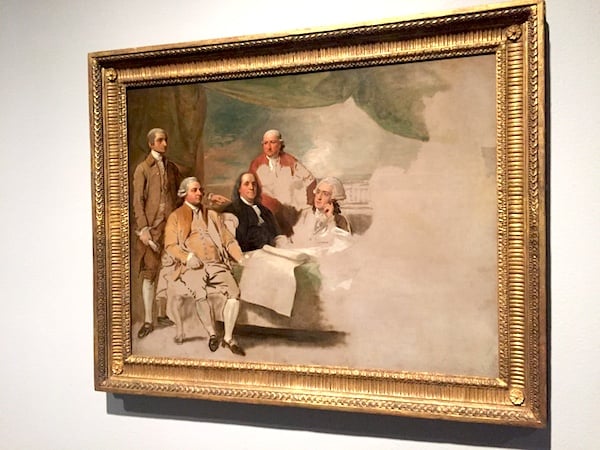
Benjamin West, American Commissioners of the Preliminary Peace Negotiations with Great Britain (begun 1783).
Image: Ben Davis.
There’s more interesting stuff in “Unfinished” than I could possibly tell you all about here. I will definitely go back.
Sheena Wagstaff, formerly a Tate Modern curator, has been brought in to spearhead the Met’s contemporary art reboot. When asked what the Met can add to a city that already has the MoMA, the new Whitney, and many smaller players, she’s repeated that “for the first time you’ll be able to enter 5,000 years’ worth of human creativity from the portal of the modern—from the now—and go backwards.”
The “Unfinished” theme is a clever curatorial conceit to demonstrate this potential, taking a very contemporary idea—the process-over-product ethos of post-1960s, post-conceptual art—and using it to reexamine the past.
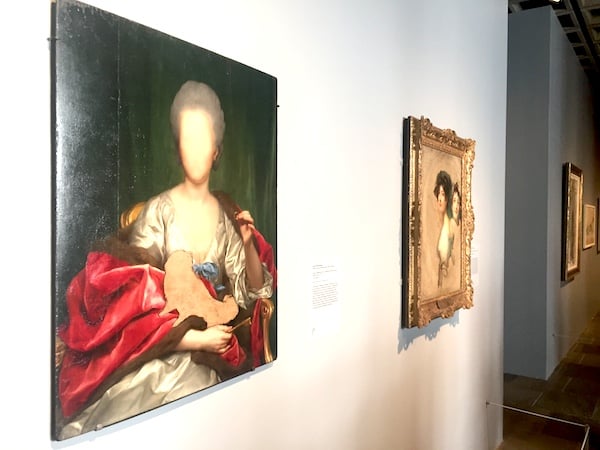
Foreground: Anton Raphael Mengs, Portrait of Mariana de Silva y Sarmiento, Duquesa de Huescar (1775).
Image: Ben Davis.
Sometimes the gambit works well here. And sometimes it half works, as with a truly weird incomplete painting by German painter Anton Raphael Mengs (1728-1779), known otherwise for urbane neo-Classicism. In his 1775 Portrait of Mariana de Silva y Sarmiento, Duquesa de Huescar, the figure and rippling folds of his sitter’s clothes are finished, but her face is rendered as a featureless void, framed by her powdered hair. Instead of a lapdog in her arms there’s a jagged lapdog-shaped hole.
The effect is eerie enough that it could definitely be a contemporary painting. A perfectly OK contemporary painting. But a great contemporary painting, I don’t know.
Notably, despite a parade of such memorable and memorably odd pieces, the show overall feels staid. Partly, the Breuer galleries have just been made to feel dim and gray. But beyond installation issues, the more significant issue is that underneath its “Unfinished” gimmick, the story of art being told feels like the typical Western canon survey march: European paintings in chunky gold frames evolving into the brainy objects of New York-style contemporary art, framed in lots of white space. It feels like a novelty-act version of art history they could have taught 20 years ago: Mainly Dead White Guys.
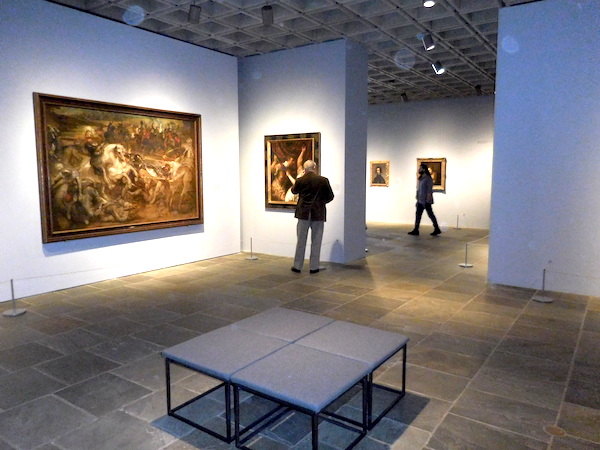
Installation view of “Unfinished.”
Image: Ben Davis.
This seems to me like a missed opportunity—but don’t take my word for it. Wagstaff told the Wall Street Journal that she’s interested in “the tension between fine art, the avant-garde and the art of vernacular.” To the New York Times, she explained, “My work at the Tate Modern… was very much about re-addressing the Western canon, re-addressing the idea of what modernism actually means, and broadening and expanding that scope.” During her tenure at the Met, she’s created new positions dedicated to South Asian, Latin American, Middle Eastern, North African, and Turkish contemporary art.
In this inaugural thesis show, none of that energy reads at all.
You are left wondering, what really is the culturally specific idea of “unfinished-ness” that holds this all together? If there is none—if it’s just a series of curatorial riffs on a theme or a bunch of unresolved questions (this is how the texts present the case, at least)—then surely there were some items in the great encyclopedic museum’s Asian, African, Middle Eastern, or Oceanic art collections that also had something to say about the subject. And surely a curatorial approach that was less focused on plodding chronology and more on scrappy juxtaposition would have been better.
(An exhibition dedicated to the late Indian painter Nasreen Mohamedi, on the Met Breuer’s second floor and curated by Wagstaff herself, seems a more promising gesture towards telling new kinds of art histories. But that deserves a separate review.)
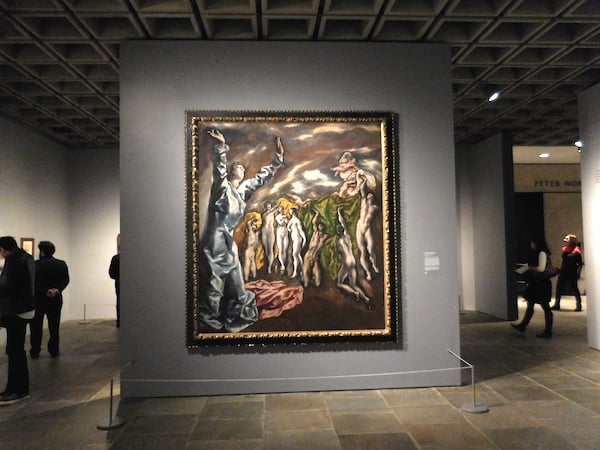
El Greco in “Unfinished” at the Met Breuer.
Image: Ben Davis.
For all the show’s strengths—and there’s after all a reason why El Greco, Rembrandt, Titian, and Co. are Old Masters—its lack of a coherent story means that it reads as a pretext, a way for the Met to do a contemporary art show that is on-brand. “[W]e’re the Met and we’re not just trying to copy our peers, we’re trying to explore a new, expanded direction for ourselves,” Wagstaff told the WSJ. “And I’m sorry for those who wanted another Jeff Koons exhibition.”
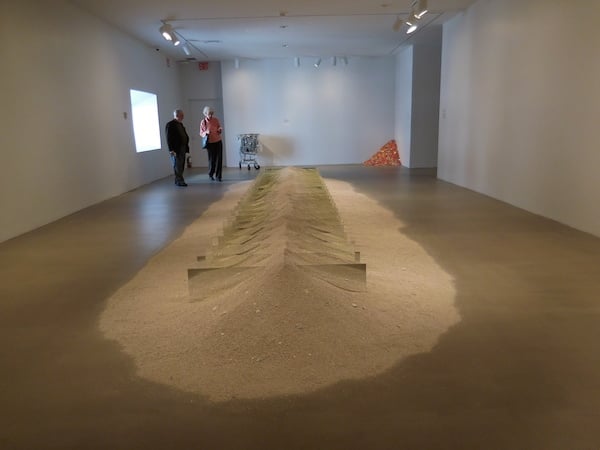
Robert Smithson in “Unfinished” at the Met Breuer.
Image: Ben Davis.
But the unforced oddness of the classical curiosities here makes the contemporary art in the show seem mannered, since the latter generally actively courts an open-ended aesthetic rather than being truly “unfinished.” Think Andy Warhol’s canvasses done in the style of paint-by-numbers, or Robert Smithson’s rows of mirrors, neatly half-buried in a pile of sand.
Simultaneously, the historical baggage that comes with that standard-issue parade-of-treasures approach prevents unleashing the lighter, more engaging energies that draw people to contemporary art in the first place.
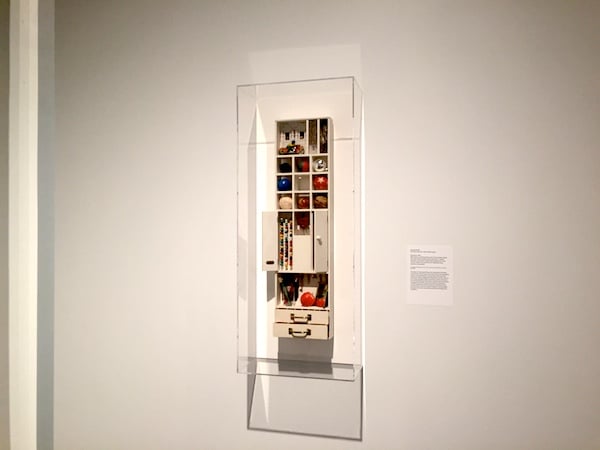
George Brecht, Repository (1961).
Image: Ben Davis.
One wall text, associated with the 1961 work Repository by Fluxus artist George Brecht (1925-2008), almost admits this fact. As presented, that work consists of a shelf, its drawers and compartments displaying a variety of playful but mundane objects, including a wooden puzzle, rubber balls, and a pocket watch. It’s all bracketed off behind a sturdy vitrine. The text reads:
The objects in this cabinet beg to be activated and handled… Repository’s power relies on the strong stimulative nature of the items, and it could never be truly finished because the viewer and the event were always changing. Now that the work has entered an institutional context, however, the need to preserve it overrides the call to participation. Thus the concept of discovery is forestalled by museum practice, leaving the eventfulness of Repository unfulfilled.
To which, they need only have added the sound of a sad trombone.
Like I said, a B is a passing grade. But the whole point of this mega-museum’s attempt to make a splashy entrance into contemporary art is to escape second-place status; the MoMA or the Whitney or the New Museum are ahead in engaging people on a contemporary wavelength.
If the Met Breuer wants to capture the attention that comes from engaging with the present, then it needs to signal that it is doing something unique and more adventurous than its peers. There is plenty of room to do so.
I’m sure I won’t be the only one to make this crack, but on the evidence of this first show, that project looks unfinished.
“Unfinished: Thoughts Left Visible” is on view at the Met Breuer, March 18 to September 4, 2016.